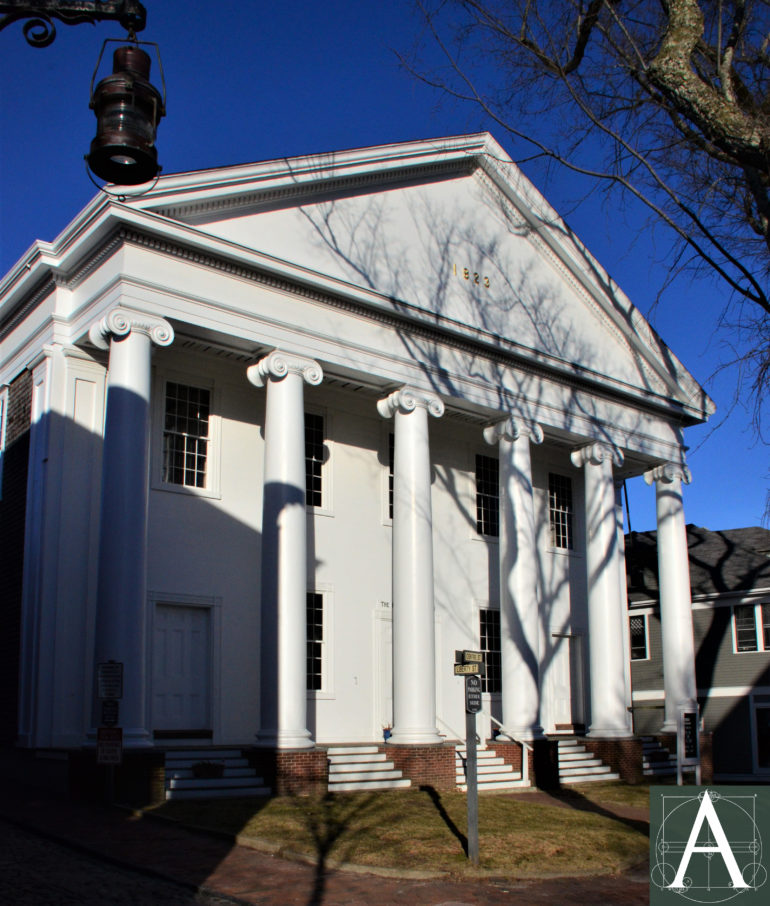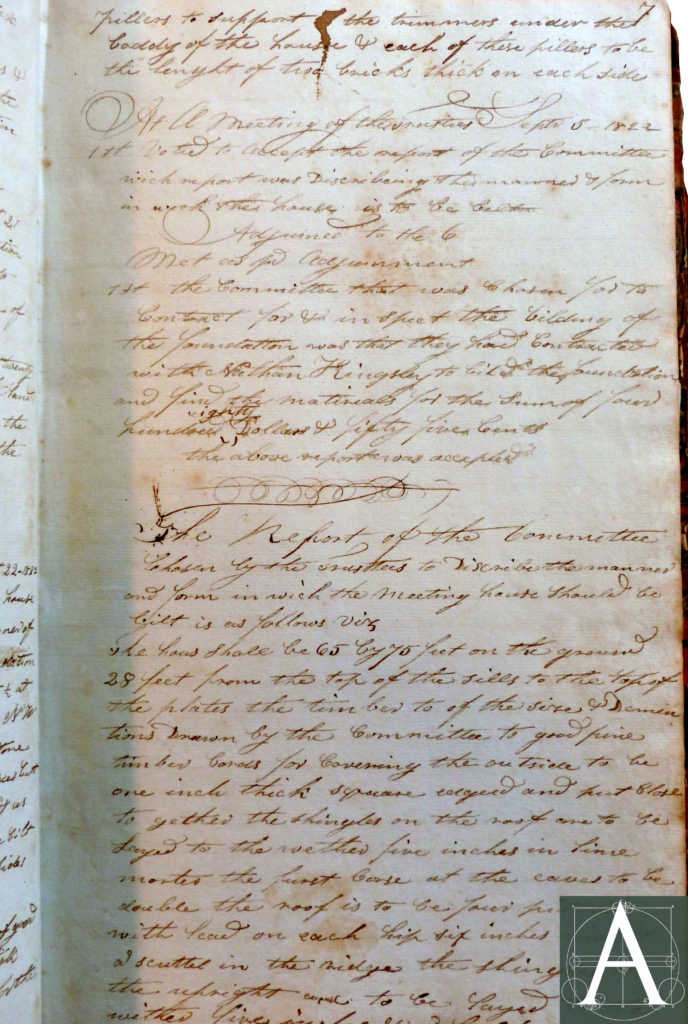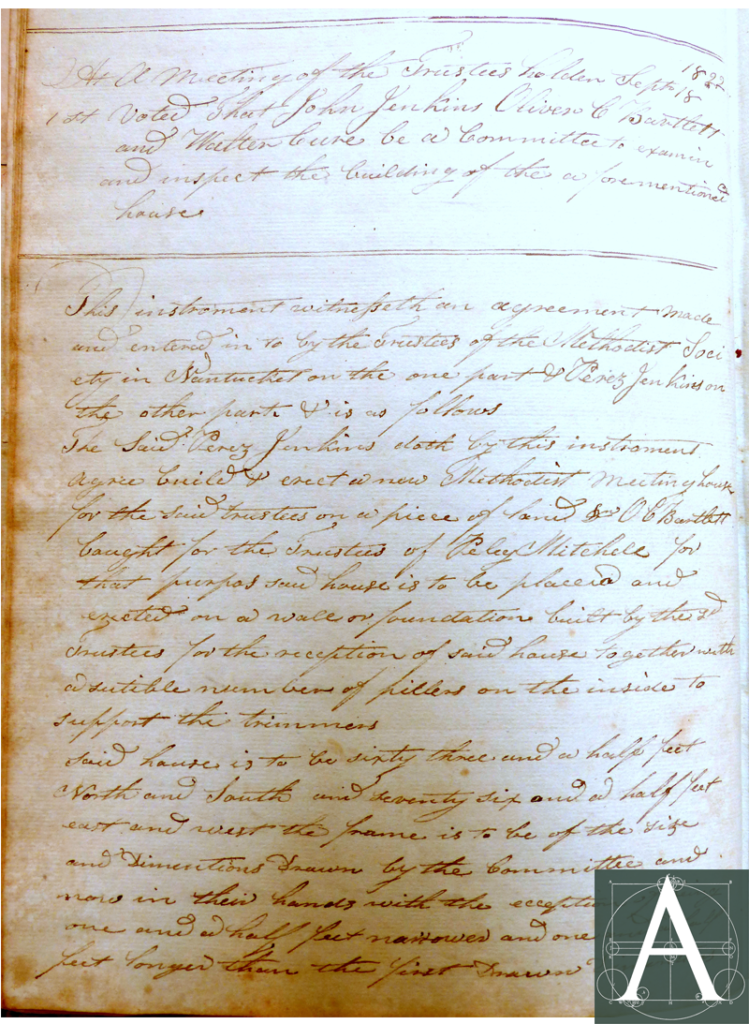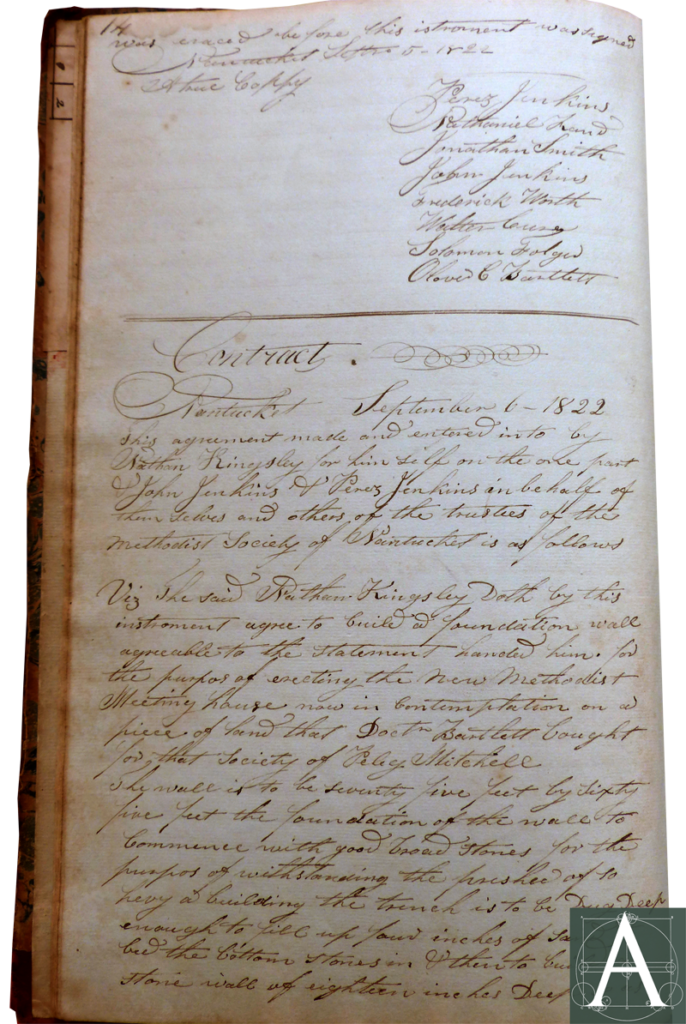The United Methodist Meeting House of Nantucket, more commonly known as the United Methodist Church of Nantucket, survives largely unaltered from its original construction in 1822-23 and its renovation in 1840. Both periods of construction are well documented in the minutes of the congregation’s trustees’ meetings from the building’s initial conception through 1906. In a pattern characteristic of New England’s independent Protestant religious societies, the meetinghouse was built by public subscription in which parishioners paid for pews that they would occupy. Known as Proprietors, parishioners who bought pews received recorded deeds and, as co-owners, incurred the responsibility of paying pro rata shares of the costs of maintaining and operating the meeting house. Decisions were frequently made by committees of parishioners selected to carry out specific tasks, such as determining the size of meetinghouse needed or its likely cost, after which they would report to trustees who, if they accepted the recommendations, would appoint a new committee (or reauthorize the existing committee) to take the next step toward construction. Detailed architectural plans were rarely drawn, and descriptions of the proposed buildings were primarily verbal, frequently including references to details from other buildings that were to be matched.
1822-23 Construction: The speed with which the building was constructed is notable by modern standards, but not unusual in its day. Initial consideration of whether to buy land and build a meetinghouse began in May 1822; the building was finished by August 1823. The sequence of votes and committees appointed by the Trustees to test the feasibility of the project, raise financial support for it, develop plans, and oversee construction presents a model of regional customs and rules of order. As recorded in the Trustees’ minutes, the process of building included the following steps:
- May 3, 1822 – The Trustees received the first report from a committee appointed to consider whether the congregation could support a meetinghouse. The committee recommended that “it is expedient and necessary to have sd New house” and proposed that the finances be arranged such that the subscription price for pews on the lower floor would be sufficient to pay for the entire cost of the building. Accepting the committee’s recommendations, the Trustees voted to proceed with the building, upon the condition that three-fourths of the pews would be subscribed before construction began.
- May 22, 1822 – The committee reported that a lot owned by Peleg Mitchell “is the most eligible site and could be had for nearly if not Quite five thousand Dollars.” The committee estimated the cost of building a 62’ x 76’ meeting house with 24 pews on the lower floor (not including seats in a gallery) at approximately $7,200, making the whole cost of the project $12,000. It is not clear why such a small number of pews was provided in this report, since subsequent reports mention more than 60 pews. It further agreed to seek subscribers and “to have our intentions Advertised in the newspaper.” Finally, a member of the committee presented a draft charter for submission to the General Court of Massachusetts to seek a charter (incorporation) as the Methodist Episcopal Society. The Trustees voted to accept these recommendations.
- May 24, 1822 – The right to purchase the current lot within a period of 60 days was secured.
- June 26, 1822 – The committee reported that it had subscribed purchasers for 62 pews. A committee of four was appointed “to fix upon a plan and give a minute description how the work shall be done and the Quantity of the lumber & co.”
- July 3, 1822 – The committee reported that “no more subscriptions obtained – mutch desultory talk.” After encouraging wealthy Proprietors to subscribe for additional pews by deferring payment until the meeting house should be finished, the committee drew heavily upon its own members to provide enough subscriptions to allow the purchase of land and additional architectural planning to proceed.
- July 24, 1822 – Land for the meeting house was placed under agreement with the seller who had sixty days to remove an existing building from the site.
- July 31, 1822 – The committee voted to issue a subscription paper “to the publick to subscribe to pay the difference between a wooden house and brick one.” By August 7th, $180 was subscribed to support a brick meeting house, but further pledges were not forthcoming, and the idea was abandoned.
- September 5, 1822 – A new committee “Chosen by the Trustees to Discribe the manner and form in wich the Meeting house should be bilt” presented its report, describing the building in careful detail down to elements such as the windows that were to contain “Boston Glass of the furst quality” in panes of 11” x 15.”
- September 6, 1822 – The Trustees awarded Nathan Kingsley a contract to build the foundation in which the details of construction were carefully enumerated, starting with a base of “good broad stones for the purpose of withstanding the presher of so hevy a building.” Above the stone base, the wall was to be built “of good Merchantable Hartford bricks…one foot thick to be layed in good lime morter.” Kinglsey was to finish the foundation by November 1, 1822.
- September 15, 1822 – The Trustees entered into a detailed contract with Perez Jenkins, a Proprietor and carpenter, to construct a meeting house “to be sixty three and a half feet North and South and seventy six and a half feet east and west” with a frame “to be of the size and Dimensions Drawn by the Committee and now in their hands with the ecception of being one and half feet narrower and one and a half feet longer than the first Drawn Dimensions.”
During construction, the committee and Trustees remained actively involved with construction details such as deciding “to have the roofs of the Meeting house painted and greed [greened?] with Perez Jenkins to Do the labor for ten Dollars” and to have two “stoves to match those in the Meeting house at Providence.” These stoves were connected by metal pipes to chimneys that rose from stones placed on the attic trusses above which they were brick. By August 26, 1823, the building was sufficiently near completion that the Trustees voted to buy “a cushion for the pulpit in green damask,” and to accept N. Rand’s offer “to whitewash the Meeting house of eighteen dollars, that being the lowest.” On September 8, 1823, woodwork at the gallery and pulpit was painted a second time and on the 18th, the Trustees authorized the expenditure of ten cents per pew to have the pew doors numbered.
Maintenance 1824-40: After September 1823, the Trustees’ records reflect minor adjustments of the interior and fencing until April 19, 1826 when the Trustees appointed Frederick Worth and William Jenkins “to be a Committy to attend to the keeping repairs of the buildings belonging to the Society.” Patterns of cyclical maintenance are discernable in the Minutes. In 1830, the building was repainted, and in 1835 efforts were made to stop rainwater from leaking under the front doors, including having “a moulding to be attached to the botom of one of them [front doors] as an experiment.” The experiment seems not to have worked, and seven months later, William Jenkins was authorized to put “Blind Doors to the Chapel for the consideration of thirty Dollars.” Presumably, these were louvered doors modeled after window blinds.
Other periodic repairs included the cleaning of the building’s interior. In 1834, the committee reported that “it was necessary to Cleanse the Inside of the house and the Windows, also to Whitewash all the walls, take down the stovepipes and have them cleaned.” The interior was cleaned again in 1837.
Despite the care with which the roof was originally built, it began to need repairs by 1836, only thirteen years after construction. By 1840, more extensive repairs were required.
1840 Alterations: In a period of time that seems astonishingly short by modern standards, the congregation moved from planning repairs to developing a plan of alteration that would add a gabled roof over the original hip roof and create the temple front on Centre Street:
- April 21, 1840 – A Committee appointed to consider repairs to the building reported:
“In the opinion of your Com. the roofs of the building need reshingling, the gutters also need to be renewed. The side-walks on the South and East sides espicially [sic.] that on the East are exceeding bad and with the roof need immediate attention. The front fence also needs to be renewed. They would also recommend that the North end of the front yard be dug of so as to admit of a passway to the Vestry on a level from the East sidewalk as there is much inconvenience and some actual danger of limbs as it now is. There are Some other things of minor importance which need to be done.”
- May 28, 1840 – The committee appointed on May 20th reported “That they have proceeded to attend to their duty so far as to get estimates and have called upon nearly all of the Proprietors and consider they have been successful equal to their most sanguine expectations they have got the consent of the greater part [of the Proprietors] to bear the assessment for the whole expence including the addition.”
- June 4, 1840 – The Trustees met with the committee to review the assessment needed to pay for the project. Breaking it down into two sets of charges, they agreed that 5% or 6% of the original cost of subscribing a pew would be the cost of necessary repairs, while 9% would be the cost of “the addition.”
- June 11, 1840 – The committee appointed to “call on Proprietors & c.” to determine if the more ambitious plan of alteration could draw upon broad support within the congregation and community reported broad support.
- June 13, 1840 – At a special meeting of the Trustees, the committee’s plan was accepted and a vote was taken “to alter the house on the outside and finish it in the same style as the Atheneum in this place.”
- September 2, 1840 – A committee of three people was appointed “to asses the late estimate of repairs on the Chapel & make out the bills.” The committee was authorized to “imploy some person to collect [the money].”
- January 6, 1841 – The Trustees in considering the 9% assessment against Proprietors, referred to the work as “…the addition or Alteration recently made on the Chapel,” indicating that construction work had been completed.
No architectural drawings survive from either the building’s original construction or its alteration in 1840. It is probable that none were made beyond small working sketches. The method by which the building’s design was established is characteristic of the period in which a building committee would work with a carpenter to establish the overall size of the structure and its materials. Interior spaces were laid out by strong regional practice in which meetinghouses typically had galleries on three sides with a pulpit on the fourth. The most desirable pews were on the ground floor, while the less desirable pews in the galleries were often held by the religious society for visitors and those who could not afford to be Proprietors. Stylistic elements such as pulpits, entries, and façades were frequently described verbally with reference to details from other buildings that were to be matched or modified. In this case, the façade of the pre-1846 Atheneum was only loosely matched insofar as it had a pedimented gable supported by Ionic columns; its proportions, doors, and fenestration were not matched.
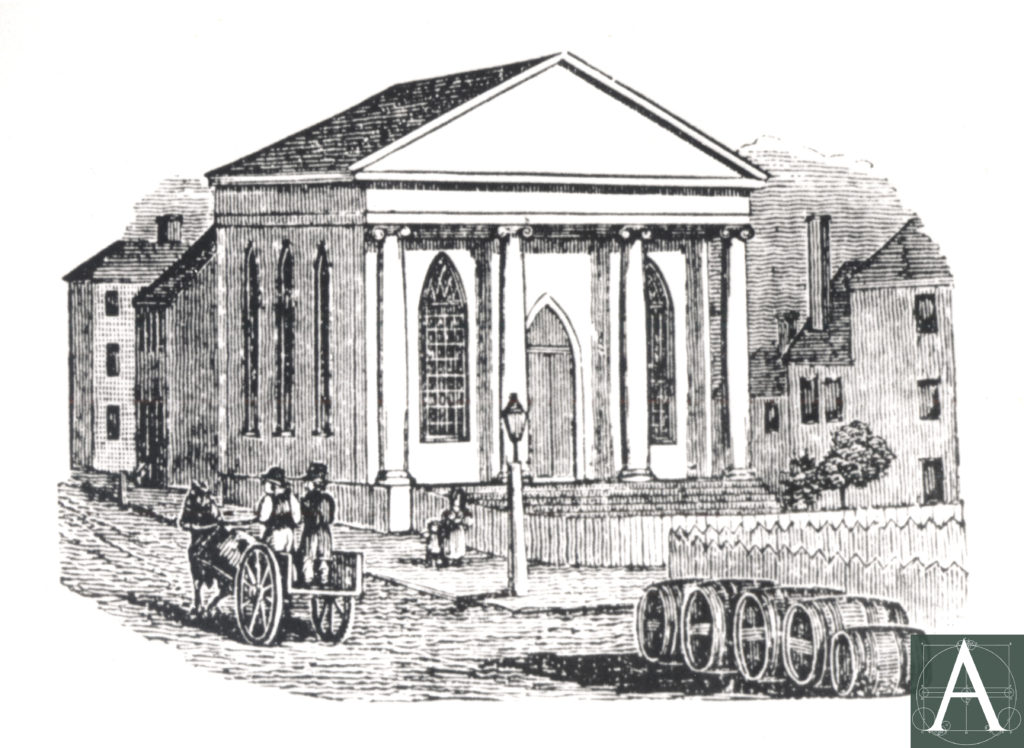
Nantucket Atheneum built 1822 as Universalist Meeting House, illustration prior to its destruction in 1846 [courtesy of the Nantucket Historical Association – Image P16011]
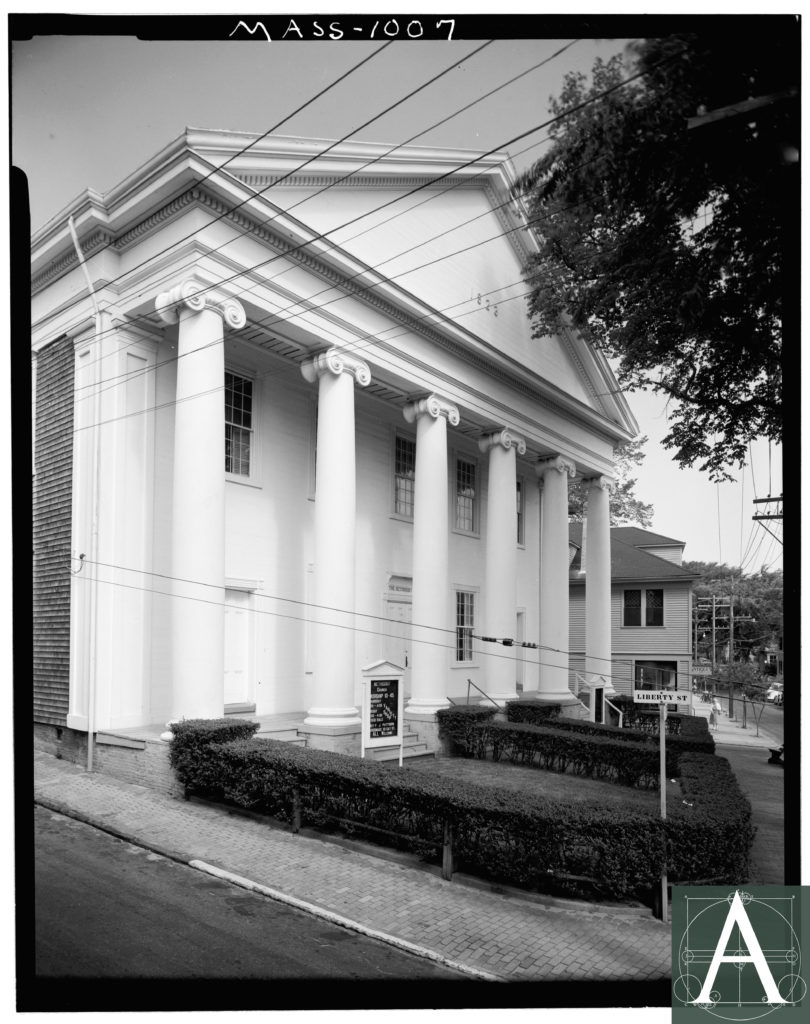
United Methodist Church – façade added 1840 [Library of Congress, Prints & Photographs Division, HABS MASS,10-NANT,74–2]

